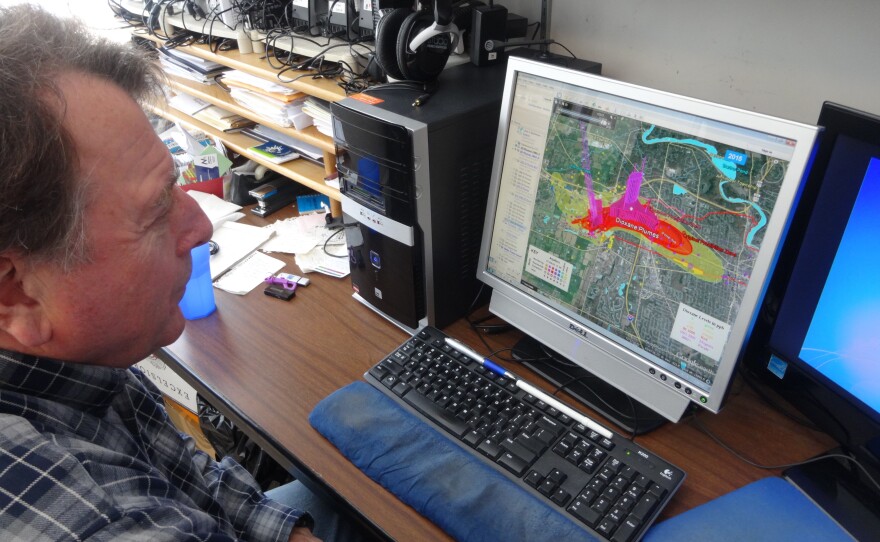For almost thirty years, a “responsible party” (Gelman Sciences, Inc.) has been legally and financially responsible for the 1, 4 dioxane contamination of groundwater inthe Ann Arbor area. This is in contrast to many contamination sites where cleanup falls totally on taxpayers. But the plume remains, and some question if enough resources are being devoted to its remediation. In this installment of WEMU’s “The Green Room,” Barbara Lucas looks at money, and how it impacts Ann Arbor’s contamination problem.
David Fair (DF)-Gelman Sciences dumped the dioxane that polluted Ann Arbor’s groundwater. Gelman was bought out by Pall, which was purchased by Danaher. Although the Gelman factory is long gone, “Gelman Sciences, Inc.” is the legal entity that holds financial responsibility for the plume. In the seventh WEMU “Green Room” segment devoted to Ann Arbor’s groundwater contamination, Barbara Lucas explores, “How does money, or lack thereof, impact the strategy used to deal with the plume?”
BL: I’m with Washtenaw County Water Resources Commissioner Evan Pratt. We’re on Wagner Road next to an extraction well. Pratt would like to see more pumping and treating.
Evan Pratt: There's dozens and dozens of these in various parts of Ann Arbor and I think we'd all love it if they had dozens and dozens more. Back in 2012 they slowed down the rate at which they pump this material out, I’m not sure what reason why.
BL: He knows that since 2005, the court-ordered goal has been “containment” of the dioxane plume, and not clean-up to drinking water standards. But he says even that low goal isn’t being met, as the plume is spreading. He’d like to see the legally-responsible polluter spend more.
Pratt: The current rate of spending is somewhere between $1 million and $2 million a year.
BL: He’s glad for the $700,000 the state legislature has allocated to the DEQ to monitor Ann Arbor’s plume. But he points out that’s taxpayer money, paying for a problem industry created. And the DEQ’s already hurting.
Pratt: In the last 15 years the DEQ’s staff has been slashed by 25% and their budget’s been slashed by almost 60%, and so they're spread pretty thin!
BL: State Representative Jeff Irwin notes how economic interests have influenced the remediation strategy negotiated in court.
Jeff Irwin: We are going to be up against Gelman, Pall and Danaher who want to hold on to as many of their dollars as possible at the expense of our groundwater and our environment here in Ann Arbor.
BL: He blames the political climate for the lack of funds.
Irwin: The law requires the DEQ to balance economic utility with the actual harm to human beings, and because here in Ann Arbor we are on city water, there has been an attitude that we can solve this by putting in place these prohibition zones, which are really just to prevent people from ever touching the water again. To me, that’s a totally unacceptable way to treat all of our water or our rights to that water.
BL: Irwin says there’s talk of proposing a more protective state standard for 1,4-Dioxane—something like 3.5 ppb. But he says there’s a political barrier.
Irwin: We are working with a majority in the state legislature that values the economy over human health, in my opinion.
BL: Some may be reassured there is a chunk of money earmarked for the Ann Arbor contamination.
Michael McClellan: Twenty-eight million, four-hundred and thirty-one thousand, eight-hundred and forty-six.
BL: That’s Michael McClellan of the DEQ. He’s referring to the “Financial Assurance Mechanism”—money Gelman, Inc. was court-ordered to set aside.
BL: What are the conditions that need to be met before those funds can be used?
McClellan: That's a line of credit that we have, so really the condition is if Gelman is unable to financially perform their obligations, under the consent judgment, we are able to use the line of credit.
BL: I meet with Roger Rayle of Scio Residents for Clean Water.
Roger Rayle: …look at the 3-D representation over the years.
BL: He shows me his computer modeling of the mass of dioxane, which in almost three decades of treatment has decreased by only a fraction. He says $28 million it’s not nearly enough to deal with what remains. But for those who’d like to see the plume tackled more aggressively, could that money be somehow be accessed, now?
Rayle: That's not going to happen anytime soon. We would have to call “The Sheriff!”
BL: Who is the sheriff?
Rayle: The EPA.
BL: Superfund?
Rayle: I guess, yes.
Barbara Lucas, 89 One, WEMU News.
DF: Should Ann Arbor apply to be added to the list of sites awaiting federal Superfund designation to remediate contamination? Stay tuned for upcoming Green Room episodes as we explore this and more.
RESOURCES:
Timeline Pall/Gelman Site, Scio Residents for Safe Water
3-D Pall/Gelman Plume maps, Scio Residents for Safe Water
Financial Assurance Mechanism (see p. 31), Washtenaw County Circuit Court 3rd Amendment to Consent Judgment





